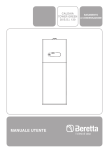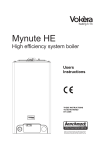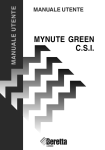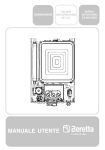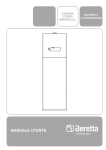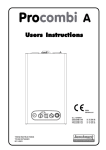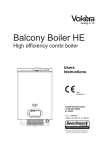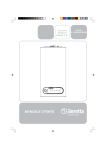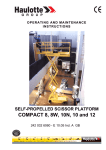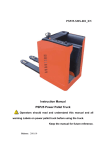Download Raypak XPAK 120 Operating instructions
Transcript
CONTENTS WARNINGS Pay Attention to These Terms For your safety read before operating 4 5 COMPONENT LOCATION General layout Control board 6 7 GETTING STARTED Before switching ON Boiler controls Lighting the boiler Adjusting the operating temperature Adjusting the hot water temperature How to top-up the system pressure How to reset the boiler 8 8 8 8 8 9 9 BOILER FAULT CODES How to shut down the system for short periods How to shut down the system for long periods How to care for the boiler 9 9 9 WHAT IF... What if I suspect a gas leak What if I have frequently have to top-up the system What if the red light is ON What if the boiler is due its annual service What if I need to call a service technician 10 10 10 10 10 MAINTENANCE Suggested Minimum Maintenance Schedule Preventive Maintenance Schedule 10 11 3 WARNINGS Pay Attention to These Terms DANGER: Indicates the presence of immediate hazards which will cause severe personal injury, death or substantial property damage if ignored. WARNING: Indicates the presence of hazards or unsafe practices which could cause severe personal injury, death or substantial property damage if ignored. CAUTION: Indicates the presence of hazards or unsafe practices which could cause minor personal injury or product or property damage if ignored. NOTE: Indicates special instructions on installation, operation, or maintenance which are important but not related to personal injury hazards. DANGER: Make sure the gas on which the boiler will operate is the same type as that specified on the boiler rating plate and on the colored sticker near the boiler gas connection. WARNING: Should overheating occur or the gas supply valve fail to shut, do not turn off or disconnect the electrical supply to the boiler. Instead, shut off the gas supply at the manual valve directly below the boiler. WARNING: Do not use this boiler if any part has been under water. Immediately call a qualified service technician to inspect the boiler and to replace any part of the control system and any gas control which has been under water. WARNING: To minimize the possibility of improper operation, serious personal injury, fire, or damage to the boiler: • Always keep the area around the boiler free of combustible materials, gasoline, and other flammable liquids and vapors. • Boiler should never be covered or have any blockage to the flow of fresh air to the boiler. WARNING: Risk of electrical shock. More than one disconnect switch may be required to de-energize the equipment before servicing. WARNING - CALIFORNIA PROPOSITION 65: This product contains chemicals known to the State of California to cause cancer, birth defects or other reproductive harm. WARNING: Improper installation, adjustment, alteration, service or maintenance can cause property damage, personal injury, exposure to hazardous materials* or loss of life. Review the information in this manual carefully. *This unit contains materials that have been identified as carcinogenic, or possibly carcinogenic, to humans. NOTE: This manual should be maintained in legible condition and kept adjacent to the boiler or in another safe place for future reference. 4 AVERTISSEMENT: En cas de surchauffe ou de non fermeture de la vanne d’alimentation en gaz, n’éteignez ou ne débranchez pas l’alimentation électrique de la chaudière. Coupez plutôt l’alimentation en gaz à l’extérieur de la chaudière. AVERTISSEMENT: N’utilisez pas cette chaudière si une partie de celle-ci s’est retrouvée sous l’eau. Appelez immédiatement un technicien de service qualifié pour inspecter la chaudière et pour remplacer toute partie du système de contrôle et toute commande de gaz s’étant retrouvée sous l’eau. AVERTISSEMENT: Une mauvaise installation, réglage, altération, révision ou entretien peut provoquer des dommages matériels, des blessures, l’exposition à des matières dangereuses* ou la mort. Examinez attentivement les informations dans cette notice. *Cette unité contient des matières qui ont été identifiées comme étant cancérigènes, ou éventuellement cancérigènes, chez l’homme. TO TURN OFF GAS TO APPLIANCE to OPEN Gas Valve CLOSED If you then smell gas, STOP! Follow "B" in the safety information above this label. If you don't smell gas, go to next step. 8. Turn gas shutoff valve counterclockwise to open valve. Handle will be parallel to pipe. 9. Install top cover. 10. Turn on all electric power to appliance. 11.Set thermostat to desired setting. 12.If the appliance will not operate, follow the instructions "To Turn Off Gas To Appliance" and call your service technician or gas supplier. 1. Set the thermostat to lowest setting. 4. Turn gas shut off valve clockwise to close valve. Handle will be perpendicular to pipe. 2. Turn off all electric power to the appliance Do not force. if service is to be performed. 5. Install top cover. 3. Remove top cover. to CLOSE Gas Valve OPEN 1. STOP! Read the safety information above on this label. 2. Set the thermostat to lowest setting. 3. Turn off all electric power to the appliance. 4. This appliance is equipped with an ignition device which automatically lights the burner. Do not try to light the burner by hand. 5. Remove top cover. 6. Turn gas shutoff valve clockwise to close valve. Handle will be perpendicular to pipe. Do not force. 7. Wait five (5) minutes to clear out any gas. OPERATING INSTRUCTIONS If you cannot reach your gas supplier, call the fire department. Use only your hand to turn the gas control knob. Never use tools. If the handle will not turn by hand, don't try to repair it, call a qualified service technician. Force or attempted repair may result in a fire or explosion. Do not use this appliance if any part has been under water. Immediately call a qualified service technician to inspect the appliance and to replace any part of the control system and any gas control which has been under water. pour ouvrir vanne gaz en arret l'étape "B" des instructions de sécurité sur la portion supérieure de cette étiquette. S'il n'y a pas d'odeur de gaz, passez à l'étape suivante. 8. Tourner le bouton de commande de gaz dans le sense antihoraire à la position "marche" (ON) 9. Remontez le couvercle du haut 10. Mettez l'appareil sous tension 11. Réglez le thermostat à la température désirée 12. Si l'appareil ne se met pas en marche, suivez les instructions intitulées "Comment couper l'admission de gaz de l'appareil" et appelez un technicien qualifié ou le fournisseur de gaz. 1. Réglez le thermostat à la température la 4. Tournez le bouton de commande de gaz dans le sens horaire à la position "arret" plus basse 2. Coupez l'alimentation électrique de 5. Remontez le couvercle du haut. l'appareil s'il faut procéder à l'entretien 3. Retirez le couvercle Cod. 20003235 COMMENT COUPER L'ADMISSION DE GAZ L'APPAREIL pour fermer vanne gaz en marche 1. ARRÊTEZ! Lisez les instructions de sécurité sur la portion supérieure de cette étiquette 2. Réglez le thermostat à la température la plus basse 3. Coupez l'alimentation électrique de l'appareil 4. Cet appareil ne comporte pas de veilleuse. Il est muni d'un dispositif d'allumage qui allume automatiquement le bruleur. Ne tentez pas d'allumer le bruleur manuallement. 5. Retirez le couvercle du haut 6. Tournez le bouton de la vanne de gaz dans le sens horaire à la position "arret" (OFF) 7. Attendre cinq (5) minutes pour laisser échapper tout le gaz. Si vous sentez une odeur de gaz, ARRÊTEZ! Passez à INSTRUCTIONS D'ALLUMAGE AVERTISSEMENT: Quiconque ne respecte pas à la lettre les instructions dans la présente notice risque de déclencher un incendie ou une explosion entraînant des dommages, des blessures ou la mort. A.Cet appareil ne comporte pas de veilleuse. instructions du fornisseur Il est muni d'un dispositif d'allumage qui - Si vous ne pouvez rejoindre le allume automatiquement le brûleur. Ne fournisseur, appelez le service des tentez pas d'allumer le brûleur incendies. manuellement. C. Ne poussez ou tournez la manette B. AVANT DE FAIRE FONCTIONNER, reniflez d'admission du gaz qu'à la main; ne tout autour de l'appareil pour déceler une jamais utiliser d'outil. Si la manette reste odeur de gaz. Reniflez près du plancher, coincée, ne pas tenter de la réparer; car certains gaz sont plus lourds que l'air appelez un technicien qualifié. Le fait de et peuvent s'accumuler au niveau du sol. forcer la manette ou de la réparer peut QUE FAIRE SI VOUS SENTEZ UNE ODEUR déclencher une explosion ou un incendie. DE GAZ: D. N'utilisez pas cet appareil s'il a été plongé - Ne pas tenter d'allumer l'appareil dans l'eau, même partiellement. Faites - Ne touchez à aucun interrupteur; ne pas inspecter l'appareil par un technicien vous servir des téléphones se trouvant qualifié et remplacez toute partie du dans le bâtiment système de contrôle et toute commande - Appelez immédiatement votre fournisseur qui ont été plongés dans l'eau. de gaz depuis un voisin. Suivez les WARNING: If you do not follow these instructions exactly, a fire or explosion may result causing property damage, personal injury, or loss of life. A. This appliance does not have a pilot. It is equipped with an ignition device which automatically lights the burner. Do C. not try to light the burner by hand. B. BEFORE OPERATING smell all around the appliance area for gas. Be sure to smell next to the floor because some gas is heavier than air and will settle on the floor. D. WHAT TO DO IF YOU SMELL GAS - Do not try to light any appliance. - Do not touch any electric switch; do not use any phone in your building. - Immediately call your gas supplier from a neighbor's phone. Follow the gas supplier's instructions. POUR VOTRE SÉCURITÉ LISEZ AVANT DE METTRE EN MARCHE FOR YOUR SAFETY READ BEFORE OPERATING For your safety read before operating Pour votre sécurité lisez avant de mettre en marche 5 COMPONENT LOCATION XPak 85 General layout (fig. 1) 1 2 3 4 5 6 7 8 9 10 11 12 13 14 15 16 17 18 19 20 21 22 23 24 25 26 27 R F G P C Water pressure switch Pump Bottom auto air vent (AAV) Gas injector Condense trap Return sensor H stamp main heat exchanger Main heat exchanger Flue thermostat Flue sensor Flue gas analysis test point Flue outlet & air intake Blocked flue switch Top automatic air vent Flow sensor High limit thermostat Ignition transformer Sensing Electrode Spark Electrode Top automatic air vent drain pipe Condensate level sensor Cylindric Burner Fan assembly Mixer Gas modulator coil Gas valve Pressure relief valve Boiler IN connection Boiler OUT connection Gas connection Pressure relief valve drain Condensate drain pipe R F G P C XPak 120 R F G Fig. 1 6 P C Control board Fig. 2 A B C G A B C D E F G E D F Pressure gauge Green led 2-digit LED display Red led Temperature selector space heating Mode selector switch Temperature selector Domestic Hot Water Off/reset - Select this position when the boiler needs to be reset or switched off. Summer mode - The domestic hot water function provided by the water tank is activated. The display indicates the storage tank temperature (only with the external water tank connected with a sensor). Winter mode - The boiler produces hot water for heating and, if connected to an external water tank, it provides domestic hot water. The display indicates the boiler flow temperature. F Winter mode tank temperature - The boiler produces hot water for heating and, if connected to an external water tank with a sensor, it provides domestic hot water. The display indicates the storage tank temperature. Temperature selector DHW- Move the temperature selector clockwise to increase the hot water temperature in the water tank or counter-clockwise to reduce the temperature (working only if a tank sensor is connected). Temperature selector Heating - Move the temperature selector clockwise to increase the heating temperature or counterclockwise to reduce the temperature. 2-digit LED display - Displays the temperature according the mode selector switch. During a fault condition, the appropriate code will be displayed (refer to the installation instructions regarding fault codes). Green LED lit - Boiler is working/responding to a heating/ tank request (flame ON). Red LED lit - Boiler has identified a fault and has shut down. Refer to installation instructions on how to reset. Pressure gauge - Ensure the system pressure is set correctly (minimum 7 p.s.i. (0.45 bar)) 7 GETTING STARTED Before switching ON Before switching the boiler on please familiarize yourself with: - how to isolate the boiler from the gas, water, and electricity supplies; - how to check and top-up – if necessary – the system water pressure; - the time clock or programmer; - any external thermostats and their functions; - the boiler controls. How to read the display temperature Fig. 3) ● (dot in the middle) = means hundred (Fig. 3) ● (dot on RIGHT side) = means DHW mode (Fig. 3a) example: Fig. 3 Heating mode 60°F 160°F DHW mode Fig. 3a Boiler controls (see Fig. 2) The boiler controls are situated on the lower front of the boiler. The boiler controls include: - Pressure gauge - Green led (burner ON) - 2-digit LED display - Red led (fault indicator) - Temperature selector space heating - Mode selector switch - Temperature selector Domestic Hot Water The pressure gauge shows the current pressure of your heating system, the gauge should be typically set between 15-22 psi (11.5 bar). When the boiler is operating the gauge may rise or fall slightly, this is quite normal. The minimum permissible level for the safe and efficient operation of the boiler is 7 psi (0.45 bar). Should the pressure fall below 7 psi (0.45 bar), the boiler may lockout. The boiler mode selector is used to switch the boiler to the various operating modes: OFF/RESET Summer mode Winter mode F Winter mode tank temperature NOTE THE BOILER FREEZE PROTECTION IS ACTIVE IN ALL OF THE ABOVE MODES. 40°F 140°F NOTICE: For temperature over 199°F (93°C) the display shows . When the status indicator (Green) is lit it indicates that the flame is detected and the burner is fully in ON status. When the fault indicator (Red) is lit it indicates that the boiler has identified a possible fault and performed a safety shut-down. Lighting the boiler Ensure the gas and electrical supply to the boiler are turned on. When power is restored to the boiler and/or the boiler is powered for the first time, the boiler start a series of checking and on the display appears a series of letters and numbers. If the checking is ok, the boiler start an automatic purge cycling for 2 minutes, the display will show as per Fig. 4. After this cycling the boiler is ready to be used. Turn the mode selector switch to the ON position. When there is a request for heating or hot water, the boiler will begin an ignition sequence. When the boiler reaches the set temperature, the burner will go off for a minimum period of approximately 3 minutes. WHEN THE ROOM THERMOSTAT HEATING REQUEST HAS BEEN SATISFIED, THE BOILER WILL SWITCH OFF AUTOMATICALLY. Fig. 4 The temperature selector DHW can be used to adjust the temperature of the water in the storage tank. The temperature range is adjustable between 95°F and 140°F (35°C and 60°C) for the tank storage temperature. can be used to adjust the The temperature selector CH temperature of the radiators or floor heating. The temperature range is adjustable between 104°F and 176°F (40°C and 80°C) for standard heating systems. Moreover if floor heating mode is selected (by using the relative jumper), the temperature range for heating mode can be modified between 68°F and 113°F (20°C and 45°C). The 2-digit LED display normally shows the operating temperature of the boiler (or storage tank temperature if fitted and the mode selector in the proper position), however it can also display additional characters or flashing numbers to signify specific operating modes or fault codes. Adjusting the operating temperature Rotate the temperature selector – clockwise to increase, counterclockwise to decrease – to the desired temperature setting. The temperature can be set between 104°F and 176°F (40°C and 80°C) standard heating systems and between 68°F and 113°F (20°C and 45°C) under-floor heating systems. NOTE If the boiler fails to ignite during the ignition sequence, it will enter a lockout condition. Should this occur, please allow a period of at least two minutes before resetting the boiler. Adjusting the hot water temperature Rotate the temperature selector – clockwise to increase, counterclockwise to decrease – to the desired temperature setting. The storage temperature can be set from a minimum of 95°F (35°C) to a maximum of 140°F (60°C) if the tank has a temperature sensor; in the case of a tank with thermostat the storage temperature is set directly on the tank thermostat. 8 How to top-up the system pressure (Fig. 5-6) The system pressure must be checked periodically to ensure the correct operation of the boiler. The needle on the gauge should be reading between 15-22 psi (1-1.5 bar) when the boiler is in an off position and has cooled to room temperature. If the pressure requires ‘topping-up’ use the following instructions as a guide. - Locate the filling valve connections (usually beneath the boiler, see Fig. 5). - Attach the filling loop to both connections (if available). - Open the filling valve slowly until you hear water entering the system. - Close the filling valve when the pressure gauge (on the boiler) reads between 15-22 psi (1-1.5 bar) - Remove the filling loop from the connections. BOILER FAULT CODES CODE ACTION REQUIRED AL10 Reset boiler. Call service technician if fault re-occurs AL20 Reset boiler. Call service technician if fault re-occurs AL21 Reset boiler. Call service technician if fault re-occurs AL26 Reset boiler. Call service technician if fault re-occurs AL28 Reset boiler. Call service technician if fault re-occurs AL29 Reset boiler. Call service technician if fault re-occurs AL34 Reset boiler. Call service technician if fault re-occurs AL40 Check system pressure and refill if necessary. Reset boiler. Call service technician if fault re-occurs control valve temporary connection control valve AL41 Check system pressure and refill if necessary. Call service technician if fault re-occurs AL52 Call service technician AL55 Call service technician AL60 Call service technician AL71 Call service technician if fault re-occurs flow/return pipe AL73 Call service technician if fault re-occurs double check valve Fig. 5 supply pipe AL74 Reset boiler. Call service technician if fault re-occurs AL79 Reset boiler. Call service technician if fault re-occurs AL91 Main heat exchanger needs cleaning. Call service technician correct pressure value IMPORTANT If the boiler requires to be reset frequently, it may be indicative of a fault, please contact your installer or Raypak Customer Services for further advice. How to shut down the system for short periods The system and boiler can be shut down for short periods by simply turning the mode selector switch to the off position. It is also advisable to turn off the main water supply to the house. Fig. 6 How to reset the boiler When the red fault LED is illuminated, the boiler will need to be reset manually. Before resetting the boiler, check what action is required to be taken, using the information on the fault code table below. Allow a period of two minutes to elapse before rotate the status mode knob. To reset the alarm, the status mode knob must be rotated to the OFF position. How to shut down the system for long periods If the house is to be left unoccupied for any length of time – especially during the winter – the system should be thoroughly drained of all water. The gas, water, and electricity supply to the house should also be turned off. For more detailed advice contact your installer. How to care for the boiler To clean the outer casing use only a clean damp cloth. Do not use any scourers or abrasive cleaners. Damage to the cabinet finish may occur. 9 WHAT IF... MAINTENANCE What if I suspect a gas leak Suggested Schedule If you suspect a gas leak, turn off the gas supply at the gas meter and contact your installer or local gas supplier. If you require further advice please contact your nearest Raypak office. Regular service by a qualified service agency and maintenance must be performed to ensure maximum operating efficiency. Maintenance as outlined below may be performed by the owner. What if I have frequently have to top-up the system Daily 1. Check that the area where the heater is installed is free from combustible materials, gasoline, and other flammable vapors and liquids. 2. Check for and remove any obstruction to the flow of combustion or ventilation air to boiler. If the system regularly requires topping-up, it may be indicative of a leak. Please contact your installer and ask him to inspect the system. What if the red light is ON If the Red LED light is illuminated, it indicates that the boiler has failed to ignite or has detected a possible fault. When this happens the boiler automatically shuts down and requires a manual reset. What if the boiler is due its annual service Advice for tenants only Your landlord should arrange for servicing. Advice for homeowners Please contact Raypak Customer Service if you would prefer a Raypak service engineer or agent to service your boiler. Alternatively your local registered service agency may be able to service the boiler for you. What if I need to call a service technician If you think your boiler may have developed a fault, please contact your installer or Raypak Customer Services. Have all your details in hand including full address, relevant contact numbers, and your complete boiler serial number. Minimum Maintenance Monthly 1. Check for piping leaks around fittings. If found, repair at once. DO NOT use petroleum-based stopleak compounds. 2. Visually inspect venting system for proper function, deterioration or leakage. 3. Visually inspect for proper operation of the condensate drains on the boiler and in the venting. If leaks are observed repair at once. 4. Check air vents for leakage. Yearly (Beginning of Each Heating Season) WARNING: Annual service should ONLY be performed by a qualified service agency. Schedule annual service by calling a qualified service agency. 1. Visually check top of vent for soot. Call service person to clean. Some sediment at bottom of vent is normal. 2. Visually inspect all flue product carrying areas of the boiler including the venting system and main burner for proper function, deterioration or leakage. Ensure that condensate drains are inspected and ensure that condensate is being directed to appropriate condensate management system or drain, as required by local codes. 3. Check that area is free from combustible materials, gasoline, and other flammable vapors and liquids. 4. Check for and remove any obstruction to the flow of combustion or ventilation air to heater. 5. Follow pre-start-up check in the Start-up section. 6. Check operation of safety devices. Refer to manufacturers’ instructions. 7. To avoid potential of severe burn, DO NOT REST HANDS ON OR GRASP PIPES. Use a light touch; return piping will heat up quickly. 8. Check blower and blower motor. 9. Check for piping leaks around pumps, relief valves and other fittings. Repair, if found. DO NOT use petroleum-based stopleak. Periodically 1. Check relief valve. Refer to manufacturer’s instructions on valve. 10 Preventive Maintenance Schedule WARNING: Preventative maintenance should ONLY be performed by a qualified service agency in accordance with the procedures listed in the heater Installation and Operating Instruction Manual. The following procedures are recommended and are good practice for all XPak installations. Daily 1. Check gauges, monitors and indicators. 2. Check instrument and equipment settings. Monthly 1. Check flue, vent, stack, or outlet dampers. Semi-Annually 1. Recalibrate all indicating and recording gauges. 2. Check flame failure detection system components. 3. Check piping and wiring of all interlocks and shutoff valves. Annually 1. Test flame failure detection system. 2. Test high limit and operating temperature. 3. Check flame sensor. 4. Conduct a combustion test at full fire. Carbon dioxide should be 8.5% at full fire for natural gas, and 10.0% for propane gas. Carbon monoxide should be < 130 ppm. 5. Check for leaks at all valve fittings using a soapy water solution (while heater is operating). Test other operating parts of all safety shut-off and control valves and increase or decrease settings (depending on the type of control) until the safety circuit opens. Reset to original setting after each device is tested. 6. Perform leakage test on gas valves. 7. Test air switch in accordance with manufacturer’s instructions. (Turn panel switch to the “On” position until blower is proven, then turn the switch to “Off”). 8. The combustion blower motor does not require lubrication for proper operation. DO NOT attempt to oil the motor or damage may occur. As Required 1. Check drip leg and gas strainers. 2. Check flame failure detection system. 3. Check igniter. 4. Check flame signal strength. 5. Test safety/safety relief valves in accordance with ASME Heater and Pressure Vessel Code Section IV. 6. Alarm 91 (AL91) the main heat exchanger need cleaning 11 www.raypak.com Raypak, Inc., 2151 Eastman Avenue, Oxnard, CA 93030 (805) 278-5300 Fax (805) 278-5468












